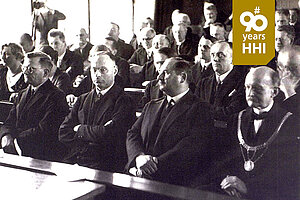1930
In order to achieve excellent research results, optimal conditions are needed, including in terms of offices and research space. This was as true during the establishment of HHI as it is today. The construction of the institute premises in Franklinstraße was therefore a real milestone.
Thanks to the membership fees of the association “Studiengesellschaft für Schwingungsforschung”, construction work on the HHI’s new premises could be started in 1928. However, as this was the time of the global economic crises, the fact that construction began was by no means a matter of course. Senior Civil Servant and Building Officer Otto Weißgerber was responsible for the design of the new building on Franklinstraße in Berlin-Charlottenburg. He envisioned a site that was optimally adapted to the future research activities of the HHI, with exceptionally well-equipped technical facilities and laboratories, an array of modern antennas on the roof, a large library, a lecture hall and many other features.
The inauguration ceremony took place on March 7th, 1930. The first speaker Dr. Adolf Grimme, then Prussian Minister of Education and Cultural Affairs, went on to become the first Director General of the Northwest German Broadcasting Corporation (Nordwestdeutscher Rundfunk) and lent his name to one of Germany’s most prestigious media awards.
The second speaker Dr. Kruckow, Head of Department at the Reichspostministerium, presented the greetings of the Ministry and reminded the audience of the German postal service’s role as an early supporter of the institute. After this, Commissioner for Broadcasting Dr. Bredow expressed his wish that the institute would become a forerunner in the development of public broadcasting in Germany. Professor Dr. Max Planck, Secretary of the Prussian Academy of Sciences, and other speakers followed. Director Professor Wagner summed up the mission of the institute as follows: “Putting oscillation research at the center of research that involves many areas of technology is now for the first time possible with the establishment of the Heinrich Hertz Institute.”
Much to the chagrin of its architect Weißgerber, the Institute’s move into the new building was delayed by half a year because of the unusually cold winter of 1928/29.
